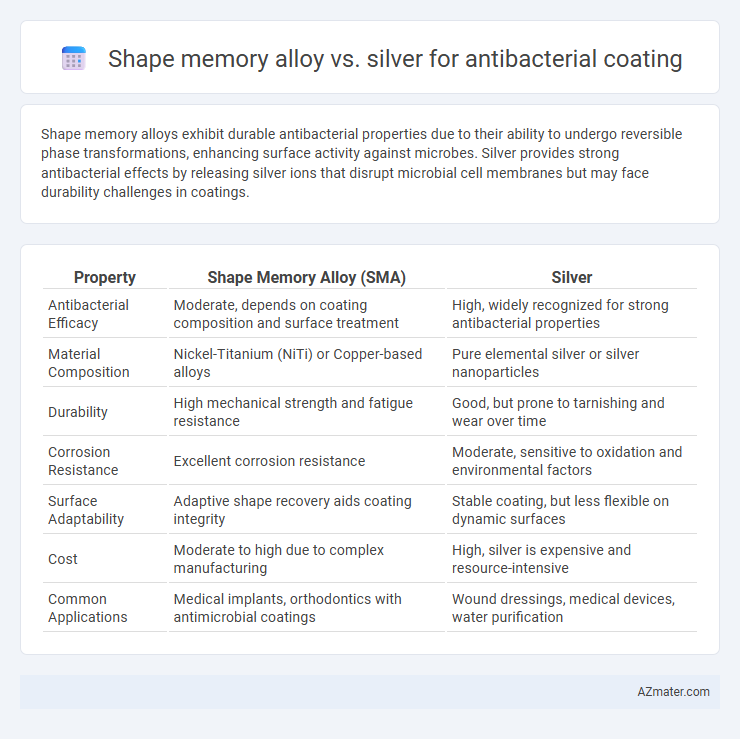Shape memory alloys exhibit durable antibacterial properties due to their ability to undergo reversible phase transformations, enhancing surface activity against microbes. Silver provides strong antibacterial effects by releasing silver ions that disrupt microbial cell membranes but may face durability challenges in coatings.
Table of Comparison
| Property | Shape Memory Alloy (SMA) | Silver |
|---|---|---|
| Antibacterial Efficacy | Moderate, depends on coating composition and surface treatment | High, widely recognized for strong antibacterial properties |
| Material Composition | Nickel-Titanium (NiTi) or Copper-based alloys | Pure elemental silver or silver nanoparticles |
| Durability | High mechanical strength and fatigue resistance | Good, but prone to tarnishing and wear over time |
| Corrosion Resistance | Excellent corrosion resistance | Moderate, sensitive to oxidation and environmental factors |
| Surface Adaptability | Adaptive shape recovery aids coating integrity | Stable coating, but less flexible on dynamic surfaces |
| Cost | Moderate to high due to complex manufacturing | High, silver is expensive and resource-intensive |
| Common Applications | Medical implants, orthodontics with antimicrobial coatings | Wound dressings, medical devices, water purification |
Introduction to Antibacterial Coatings
Antibacterial coatings enhance surface hygiene by preventing bacterial growth and biofilm formation, critical in medical and environmental applications. Shape memory alloys (SMAs) offer dynamic surface properties and corrosion resistance, which can be leveraged for antibacterial effects, while silver possesses inherent broad-spectrum antimicrobial activity through ion release disrupting bacterial cells. Comparing SMAs and silver in coating applications involves examining durability, biocompatibility, and specific antimicrobial mechanisms for optimized infection control.
Overview of Shape Memory Alloys in Antibacterial Applications
Shape memory alloys (SMAs) exhibit unique properties such as superelasticity and thermally induced phase transformations, enabling dynamic responses in antibacterial coatings. Their ability to undergo reversible deformation aids in disrupting bacterial adhesion and biofilm formation on surfaces. Compared to silver, which relies primarily on ion release for antimicrobial effects, SMAs offer mechanical antimicrobial mechanisms that reduce the risk of bacterial resistance development.
Silver as a Traditional Antibacterial Agent
Silver has been widely recognized as a traditional antibacterial agent due to its strong antimicrobial properties and ability to disrupt bacterial cell membranes and DNA replication. Shape memory alloys offer innovative mechanical benefits but lack the well-documented bactericidal efficacy and broad-spectrum activity inherent to silver. The long history of silver use in medical and consumer products underscores its superior reliability and effectiveness in antibacterial coating applications.
Mechanisms of Antibacterial Action: Shape Memory Alloy vs Silver
Shape memory alloys (SMAs) exhibit antibacterial properties primarily through mechanical disruption, where their unique reversible deformation can physically damage bacterial cell membranes. Silver, in contrast, kills bacteria via the release of Ag+ ions that interact with microbial proteins, DNA, and cell membranes, causing oxidative stress and cellular dysfunction. While silver relies on chemical cytotoxicity for broad-spectrum antibacterial effects, SMAs leverage biomechanical action with potential for reduced resistance development.
Biocompatibility and Safety Comparison
Shape memory alloys (SMAs), particularly nickel-titanium variants, exhibit excellent biocompatibility with minimal cytotoxicity and good mechanical properties, making them suitable for long-term antibacterial coatings in medical implants. Silver, renowned for its potent antimicrobial effects, poses risks of cytotoxicity and potential argyria with prolonged exposure, raising concerns about its safety in vivo. Comparative studies highlight that SMAs offer superior biocompatibility profiles and safer integration within human tissues compared to silver-based coatings, which may cause localized tissue irritation or toxicity.
Durability and Longevity of Antibacterial Properties
Shape memory alloys (SMAs) exhibit superior durability due to their inherent mechanical flexibility and resistance to fatigue, maintaining antibacterial efficacy through repeated deformation cycles. Silver coatings, while highly effective antibacterial agents initially, tend to suffer from ion depletion and surface wear over time, reducing their longevity. The unique thermo-mechanical stability of SMAs ensures sustained antibacterial properties far longer than the relatively short-lived silver ion release in conventional coatings.
Resistance Development: Addressing Bacterial Adaptation
Shape memory alloys exhibit enhanced resistance to bacterial adaptation compared to silver antibacterial coatings due to their dynamic surface properties and ability to return to an original shape, which disrupts biofilm formation. Silver coatings, while effective initially, often face accelerated resistance development as bacteria evolve mechanisms such as silver ion sequestration and efflux pumps. Continuous stress-induced changes in shape memory alloys reduce bacterial colonization, making them a promising solution to mitigate long-term resistance in antimicrobial applications.
Environmental Impact of Shape Memory Alloys and Silver
Shape memory alloys (SMAs) offer a longer lifespan and recyclability, reducing environmental waste compared to silver coatings that often require frequent reapplication due to tarnishing. The mining and production of silver involve high energy consumption and toxic byproducts, posing significant ecological risks, while SMAs, typically based on nickel-titanium, present lower extraction impacts and improved durability. Biocompatibility and reduced metal ion release from SMAs further minimize ecological toxicity, making them a more sustainable option for antibacterial coatings.
Cost-Effectiveness and Scalability for Industrial Use
Shape memory alloys offer moderate cost-effectiveness and excellent scalability for antibacterial coatings in industrial applications due to their durability and reusability, despite higher initial material costs compared to silver. Silver provides superior antibacterial properties but incurs higher costs and limited scalability challenges due to material scarcity and more complex coating processes. Industrial use favors shape memory alloys when balancing long-term operational costs and scalable manufacturing over the premium antibacterial efficacy of silver.
Future Trends and Innovations in Antibacterial Coatings
Shape memory alloys (SMAs) are emerging as innovative antibacterial coatings due to their unique ability to respond to thermal or mechanical stimuli, enabling self-healing and dynamic surface properties that enhance bacterial resistance. Unlike traditional silver coatings, SMAs can integrate with smart technologies for targeted antimicrobial action, reducing the risk of bacterial colonization and biofilm formation in medical and industrial applications. Future trends focus on hybrid coatings combining SMAs with nanosilver particles to synergistically improve durability, reactivity, and long-term antimicrobial efficacy.

Infographic: Shape memory alloy vs Silver for Antibacterial coating
 azmater.com
azmater.com